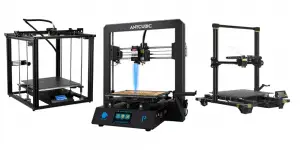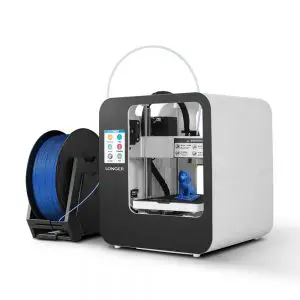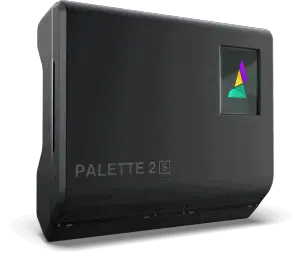The future of 3D printing is a bright one with an abundance of opportunities for the regular DIYer, or seasoned professional, to strike out on their own where they wouldn’t be able to before. From cutting edge manufacturing accessibility to building products in the convenience of one’s home, 3D printing is proving itself to be a technology that will soon be adapted like every other piece of household electronics equipment.
Remember the days when paper printing was all the rage and suddenly households everywhere were able to upgrade to laserjet and print photographs? No more long lines at the photo shop or pharmacy. Gone were the days of sorting through hundreds of doubles and splotchy images. There was no longer a need to print an entire roll of film because the convenience of digital photography and photo printing at one’s fingertips made that obsolete.

Much like the advancement of paper printing to photo printing, the next stage of 3D printing gives even the most novice users a chance to print quality products that they no longer have to buy. There are some pros and cons to 3D printing becoming a household staple. Let’s take a look at some specific areas where 3D printing will have the most impact on society.
3D Printing’s Economic Impact

Jobs: Lost & Found
It’s the way technology goes that inevitably puts some jobs and even industries out to pasture. Occupations that used to require human hands like the assembly line use robotics, but with that replacement comes an entire new industry of robotic repair and maintenance.
3D printing’s economic impact will arise in the employment sector when it eliminates jobs that used to be farmed out to larger companies, or professionals with expensive expertise. Toys, parts to machinery and devices, tools, jewelry, and even medical grade equipment can be created with a 3D printer which may put some manufacturers out of work or slow down their production entirely where they have to lay off staff or entire departments.
The upside to this is even though jobs will be lost, there will be an increase in occupations, and even a few that have to be created, surrounding the 3D printing industry. Repair services, installation techs, technical support, software, education, and 3D printer custom engineers are just some of the jobs that will be available as the industry picks up speed.
The Expense of It All:
At the present time, 3D printers are expensive in comparison to the standard paper printer. It requires special filaments to print with and not every filament is created equal. Some 3D printing companies require users to purchase proprietary build materials to guarantee full operation of their machines while other companies allow third-party filaments to be used. While shelling out a few hundred bucks for the printer itself may not be too much of a burden, it’s often the consumables that start to put a dent in the user’s wallet. Here are some of the items 3D printers go through on a regular basis:
Filament 3D Printers
- Filaments: PLA, ABS, NYLON, TPU, HIPS, GLASS, METAL, & Other exotics
- Hot ends: the tip where the filament comes out can be swapped for other sizes with the industry standard being .40 mm diameter nozzle.
- Motors and fans
- Print beds and Buildtak
- Axis connection cables
Photocuring Resin 3D Printers
- Build materials: Photocuring resin
- FEP film
- Resin vats
- Print bed
- Ultraviolet post build curing light sources
It’s important to take into consideration the moving parts of 3D printing as normal use will cause some of these things to be replaced more often than others.
3D Printing’s Environmental Impact

Reuse & Recycle:
When it comes to the build materials, there’s going to be waste from the build process. There will be bits of pieces fished out of the printer’s extruder or Bowden tubing. There will be builds that have to be scrapped altogether because the design is flawed, the user is inexperienced, or the printer software went bonkers. Throwing away unusable filament is a lot more detrimental to the environment than tossing crumpled pieces of paper into the trash.
Paper is easily recycled while filament isn’t always biodegradable and it can’t be sorted with regular plastics into the typical recycling bin. However, all is not lost. There are 3D printer companies that sell filament recycling machines. They’re normally compact and don’t take up too much space. Some companies offer to haul away your filament scraps too. The filament scraps are shredded, melted down, and spun into a new spool of filament that can be used to print new builds.
Printing to Prevent Pollution:
It’s a hard pill to swallow that 3D printing can prevent pollution when many of its components aren’t recyclable. The best way to look at this is with the advancement of 3D printing technology; larger corporations can take advantage of it and lower their manufacturing and transportation costs. A company that can mass produce electronics equipment in their corporate headquarters located in the United States off of a 3D printer won’t have to import these parts from another country. By trimming down transportation needs, less pollution will be a natural byproduct even when the filament itself can’t be recycled.
Another pollution reducing aspect of 3D printing comes with the convenience of having printers for home use. Where professionals would have to hire out specialists to construct various items like design models, prototypes, jewelry, and even dental casting, many of excess materials that go into producing these items can be cut since they don’t have to be a part of a mass order. It reduces waste to have the convenience of a 3D printer at one’s fingertips.
3D Printing’s Social Impact

Social Divide, Learning, and Accessibility:
Whenever technology advances, it happens that the lower income residents of society tend to be last on the totem pole. However, with 3D printing becoming more affordable, along with the advent of kid-friendly machines and software, it’s possible for children and individuals of all backgrounds to have access to 3D printing. Many schools are including 3D printers in the classroom and there are some online learning academies and tutorials dedicated to teaching everyone the process.
When it comes to the filaments, there are new advancements released steadily that allow products to be constructed out of various materials, especially when printing with fabric type filaments, there’s a distinct possibility of creating clothing for households, organizations, and the community at large. The opportunities to close the social divide are abundant because of the reduction in labor and costs to produce necessities will now have the capability of being printed in the home, office, or lab.
Another aspect of accessibility is with businesses and homes outside of largely populated cities. 3D printing doesn’t have to be a tool solely used in a booming metropolis. It can save money and time in those hard to reach areas where they can print tools and parts for projects or repairs instead of waiting for an order to be shipped out to them.
Creatives Coming Together:
When 3D printing picked up steam amongst professionals, it was still a fairly expensive process. To combat the high costs, some businesses formed co-ops, or community workspaces where they could share their resources and equipment. When like-minds come together, especially in the creative sector, innovation comes with new products, processes, and in solutions.
3D printing helps forge new relationships with spur creativity that give us results like 3D printed organs and medical supplies, easily printed dental casts and molds because who wants to spend more time at the dentist than necessary? Let’s not forget the entertainment aspect of being able to print odd items you’re not likely to find elsewhere, like a missing Monopoly piece or any other board game for that matter.
On the environmental side, there are initiatives where water purifying straws can be printed en masse and distributed to necessary countries and communities along with other revolutionary products.
The world is changing and 3D printing is no longer the product of some science fiction fantasy. The opportunity to create and innovate in areas never imaginable in the confines of someone’s home is now open to explore. The impact will be both good and bad, but such is the nature of technology. Overall, the future of 3D printing has way more pros than cons when it comes to its impact on society.




